The Secret Game of Tennis Part 3:
Confidence in the Center
by Jack W. Broudy
This is the third in a series of five articles, providing additional insight into The Secret Game of Tennis. If you have not read the previous two articles, we suggest you read them first to better understand today’s addition.
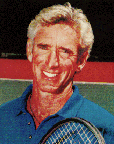
The standard school of thought on hitting a tennis ball has always been based on racket positions; racket back, hit out in front, follow-through. These ingredients along with an emphasis on hard work, running, fitness, and hitting countless balls creates about one player in every hundred thousand, leaving the others strewn across the landscape - statistical tennis casualties. This linear approach to the game is killing tennis and robbing club players and newcomers of any enthusiasm they might have developed. It produces a mechanical attack-and-defend mentality, and a jagged game style seen even in some touring pros. Not all the professional tennis players hit with the roundness and fluidity of an Aggassi, Sampras, or Hingis.
Let’s face it, there are two different games going on out there, pretty and pretty ugly. It’s this task-oriented, linear approach to the game that makes most players unable to move gracefully with the ball and throughout their strokes. They seem to be too close or too far away or the ball’s too high or somehow just out of the comfort zone. How often have you heard a coach or instructor say, get sideways, racket back early, freeze your finish, etc.. Yet the real players, (the ones we enjoy watching) seem to be in a constant fluid motion, always rolling from one shot into the next. Nothing mechanical looking there. These players always seem to be in the right spot, at the right time. They actually enjoy the stroke and the long rallies rather than fear them. They appear to suck the ball into an unmissable vortex and then fling it out into the court wherever they desire and that is precisely what is happening. Automatic yet graceful - like Michael Jordan hitting an eight foot jumper. Money-in-the-bank. These are the ‘Knights of Tennis’.
What separates the Knights from the rest of us who are still desperately seeking mediocrity? Most players and coaches will tell you it is God-given talent and, to some extent, that’s probably true. Hard work and hours of practice will send the cream of the athletes to the top. However, there is a secret to their success, whether they know it or not, and anyone can emulate it. It’s their connection to center that allows them to play with confidence and creativity.
Let me explain using a player like Eric Riley, one of my top juniors, a 12 year old from Southern California, ranked #2 in his age group. Among his achievements, Eric is a So. Cal. Sectionals Finalist, Winner of the National Clay Court -Doubles, and Winner of the National Hardcourt-Doubles. Eric understands that everything begins with and relates to the center (physically the diaphragm). It is the focal point that initiates the movement of the rest of the body, allowing it to effortlessly stroke the ball. Even while waiting for the ball, a Knight constantly reevaluates and renegotiates his/her relationship to it.
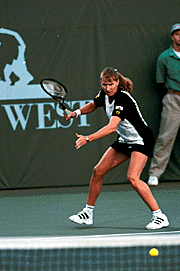
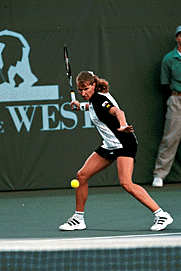
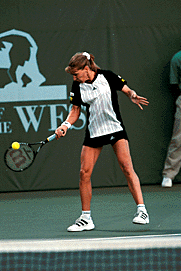 The first thing that moves when your opponent strikes
the ball should be your center. See (in the illustration below, figure 1) how Graf's
center moves backward pulling the racquet behind her. Her feet move next orienting her
center to the ball. As the ball draws nearer, she seems to suck it in, with her belly
pulling towards the back fence (figure 2), her shoulders, arms, and racket head trailing
(in that order). Then, as her racket makes it back, catching up to her belly, she shifts
her belly forward towards the net in one continuous motion (figure 3). This action, when
preformed correctly, creates a whip cracking effect, releasing all the power of the
racquet (figures 4 and 5).
The first thing that moves when your opponent strikes
the ball should be your center. See (in the illustration below, figure 1) how Graf's
center moves backward pulling the racquet behind her. Her feet move next orienting her
center to the ball. As the ball draws nearer, she seems to suck it in, with her belly
pulling towards the back fence (figure 2), her shoulders, arms, and racket head trailing
(in that order). Then, as her racket makes it back, catching up to her belly, she shifts
her belly forward towards the net in one continuous motion (figure 3). This action, when
preformed correctly, creates a whip cracking effect, releasing all the power of the
racquet (figures 4 and 5).
Eric understands the mechanics of this fluid, snap of the whip motion and has internalized into his game. It is the most natural way to hit the ball because it never taxes any part of the body. The natural balance and harmony produce power along with effortless control and can be performed while remaining perceptive to the on-court situation. Constantly focusing on and moving from the center keeps Eric in the game and each shot and movement is equally poised when he stays in this endless situation.
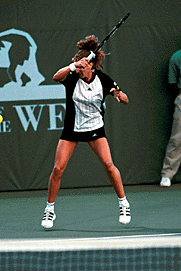
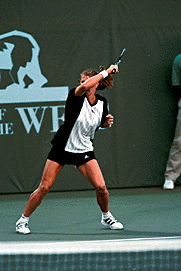 That’s how a
player like Rios can pound winners during a baseline exchange against players much bigger
and stronger than he is. Like Rios, most of Eric’s peers are also bigger but Eric
incorporates his body’s natural synergy allowing him to play big. It’s the way
he thinks out there.
That’s how a
player like Rios can pound winners during a baseline exchange against players much bigger
and stronger than he is. Like Rios, most of Eric’s peers are also bigger but Eric
incorporates his body’s natural synergy allowing him to play big. It’s the way
he thinks out there.
This beautiful geometry of tennis also relates to the mental aspects of the game. How do you pay attention and focus, when so many things can interrupt concentration? How do these systems in your mind work, as you perform the strokes? When your head is filled with thoughts of symmetry, it functions better. Create the symmetry as a dancer choreographs movements in relation to the whole. It takes imagination to be a beautiful dancer and the same imagination applies to tennis. Once you apply creativity to this secret, non-linear approach, it all comes together.
So when you watch the great players, focus your attention on their hips and center (click here to see
Graf animation). Notice how the players with the pretty games, twist open both hips
just slightly before contact with the ball with the body pulling the arm, creating a whip
behind them. The small center point turn creates a large periphery, and the timing of the
hip rotation creates a snappier whip.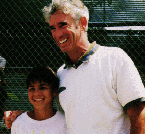 Notice how all movement is initiated from the center.
Notice how all movement is initiated from the center.
Anyone can play the type of tennis they see on TV by getting connected and staying connected to their center. This, coupled with the figure 8 (see previous lesson in series) is the key to the secret game. Once you begin this journey into the center you’ll begin to feel like a real player, effortless and free from the score, a knight of the game. For his efforts and dedication, Eric received the first ‘Knight of the Day’ award, so named by partner, Paul Mayberry, and myself. This young man exemplifies the characteristics and key principles that define The Secret Game of Tennis and its Secret Society of Knights. Congratulations Eric.
Send email to the author
We encourage you to email your comments (pro, con, appreciative, whatever) directly to the author. To send email to Jack Broudy, click here.
Visit the TennisONE Library to see Jack Broudy's complete series on
The Secret Game of Tennis.To contact us, please email to: webmaster@tennisone.com
TennisONE is a registered trademark of TennisONE and SportsWeb ONE; Copyright 1995. All rights reserved.
